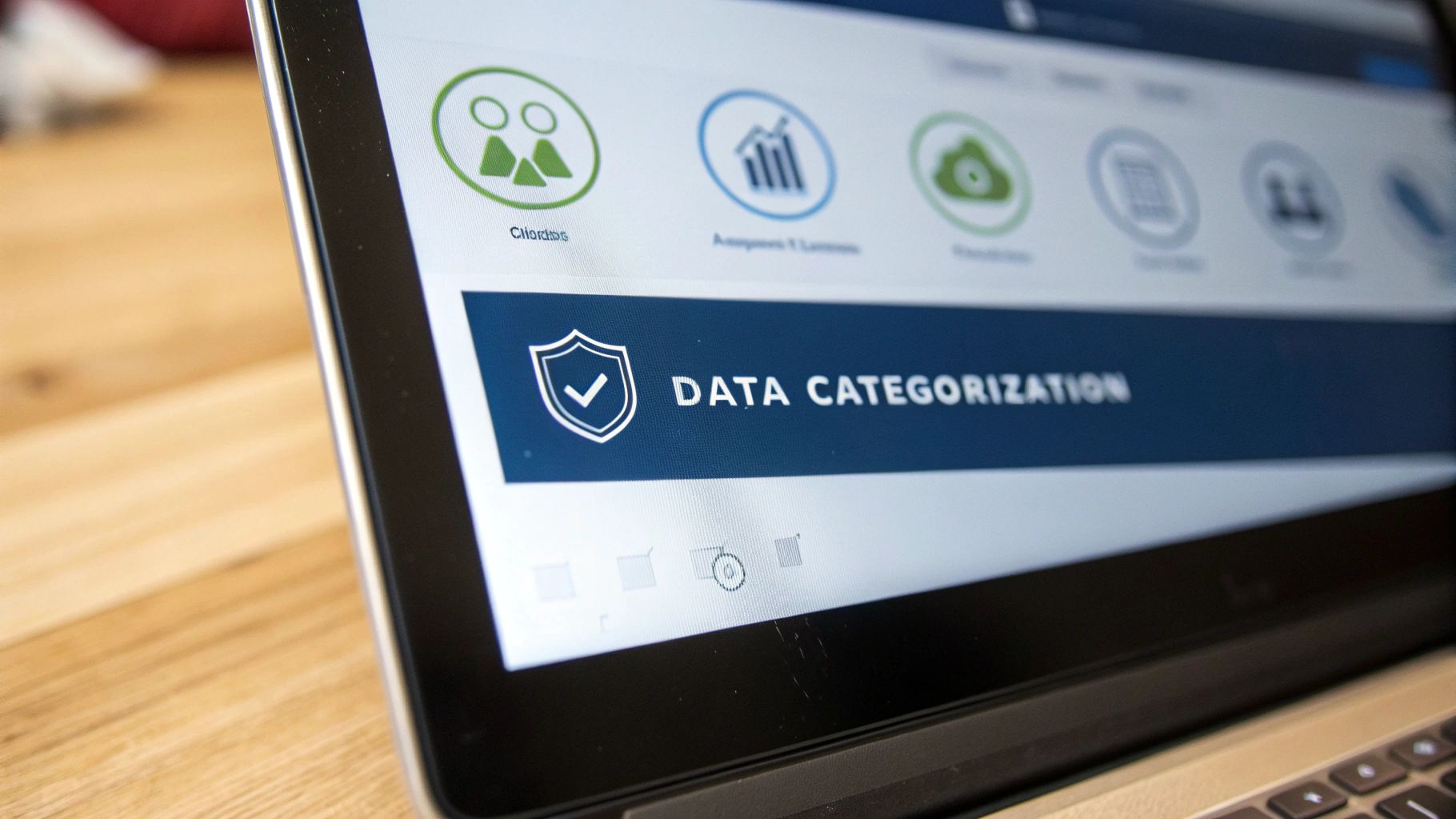Essential Data Classification Policy Template: Your Complete Guide to Implementation
Understanding Data Classification Policy Fundamentals

A strong data classification policy provides the essential framework for any organization's data security strategy. This policy has become a critical necessity, not an optional component, for businesses of all sizes. The policy creates clear guidelines for categorizing data based on its sensitivity level, value, and compliance requirements. Without proper data classification, organizations risk exposing themselves to data breaches, compliance issues, and damage to their reputation.
Why is Data Classification So Vital?
The massive growth in data creation has made classification more important than ever before. By 2025, experts project global data creation will exceed 180 zettabytes, climbing to more than two thousand zettabytes by 2035 - driven heavily by advances in AI technology. Find more detailed statistics here. This explosive data growth means organizations must have clear policies for organizing and protecting information based on its sensitivity and importance. Smart data classification also helps companies direct their security resources effectively, focusing protection on their most valuable and sensitive assets rather than applying blanket measures across all data.
Key Components of a Data Classification Policy
An effective policy needs several core elements to succeed. First, it must define clear classification levels - typically ranging from "Public" to "Highly Confidential" - with specific criteria for each level. The policy should also spell out roles and responsibilities, making it clear who classifies data, implements security controls, and monitors compliance. Finally, it must include detailed handling procedures that explain exactly how to store, access, share, and ultimately dispose of data at each classification level.
Building a Culture of Data Security
A data classification policy only works when it becomes part of the organization's culture and daily operations. Employee training and awareness are essential - staff need to understand how to apply the policy in their work and why compliance matters. Check out our guide on data retention policy templates for more insights. When data classification becomes part of an organization's DNA, it creates strong security habits that protect against threats while building trust with customers and partners. Proper implementation shows stakeholders that an organization takes data protection seriously.
Building Your Classification Framework That Actually Works

A solid data classification policy is essential for protecting sensitive information. However, having just a policy document isn't enough - you need a practical framework that puts those policies into action. Let's explore how to create a data classification system that works effectively for your organization.
Establishing Actionable Classification Levels
Start with clear, well-defined classification levels that make sense for your needs. Most organizations use a simple tiered system - from "Public" to "Highly Restricted." Each level needs specific criteria. For example, "Public" data might include website content, while "Highly Restricted" covers sensitive financial records and customer data. Make these criteria measurable and specific to ensure consistent application.
Developing Effective Classification Criteria
When creating your criteria, consider key factors like:
- Potential impact if data is exposed
- Business value of the information
- Legal and regulatory requirements
- Industry compliance standards
Organizations often struggle with subjective interpretations of data sensitivity levels. To address this, involve key stakeholders from IT, legal, and compliance teams to create aligned policies. Learn more about effective data classification strategies here: Data Classification Policy Guide
Using Technology Tools
Modern data classification benefits from smart technology tools. Automated classification systems can apply rules consistently across large datasets. AI tools help spot patterns that suggest sensitive data requiring higher protection. However, maintain human oversight for complex cases that need careful judgment.
Creating Adaptable Templates
Your data classification policy should fit your specific needs. Consider:
- Industry regulations that apply to your data
- Your organizational structure
- Types of data you handle regularly
- Required security controls
Include clear guidelines for handling data at each classification level, covering proper storage, access controls, sharing rules, and disposal methods.
This approach creates a practical framework that grows with your organization. Focus on making policies that are clear, actionable and help protect sensitive information effectively.
Transforming Policy into Practice: Implementation Strategies

Having a good data classification policy template is just the start. The real work comes from putting it into action within your company. This requires coordinating people, processes, and tools. When done right, implementation makes your data classification policy a core part of your security approach.
Training and Awareness: Empowering Your Team
Your team needs proper training to make the policy work. Create clear education programs that teach employees why data classification matters, what categories you use, and how to handle different types of data. Give practical examples like how to properly label sensitive documents and emails to prevent accidental data exposure. Regular refresher training helps keep these practices top of mind.
Measuring Adoption and Identifying Gaps
Tracking progress is an ongoing effort. Monitor key metrics like the percentage of correctly classified data and how often policy rules are broken. This shows where you may need more training or policy updates. Regular audits help spot weak points and make sure all departments follow the rules consistently.
Using Technology Effectively
The right tools make data classification easier and more consistent. Software can help label data, control access, and watch data movement. But you still need human oversight, especially for complex data decisions. Review and update policies regularly as data types and regulations change. Do regular checks for data that isn't properly tagged, using automation to find and classify it. Schedule yearly or more frequent reviews to keep classification rules current with business needs.
Building a Culture of Security
Success depends on making security part of your company culture. Help employees see data classification as a vital part of their jobs, not just extra work. Consider rewarding good security habits to encourage the right behaviors. For more insights, see Data Classification Best Practices. Want to improve your document management? Check out How to master document management best practices. When you combine clear rules, good training, helpful technology, and strong security culture, your data classification policy becomes a powerful way to protect company information.
you mentioned additional parts. Can I see the example blog posts?
Customizable Templates and Real-World Examples

Creating a data classification policy doesn't have to be overwhelming. Using a data classification policy template helps simplify the process significantly. This section offers practical examples and templates you can customize for your needs, providing a solid foundation that you can adapt to your organization's specific requirements.
Accessing Pre-Built Templates
There are many ready-to-use data classification policy templates available. These templates typically include essential sections like purpose, scope, roles and responsibilities, and data classification categories. Most templates use standard categories like "Public," "Internal," "Confidential," and "Restricted." This structure ensures you cover all the key elements needed for an effective policy.
Real-World Examples: Adapting Templates for Success
While templates offer a good starting point, you'll need to modify them based on your specific needs. This means adjusting the classification categories and handling procedures to match your industry requirements and data types.
- Example 1: Healthcare: Medical organizations must follow HIPAA guidelines. Their policy templates need specific sections addressing protected health information (PHI) and include detailed access controls and encryption requirements.
- Example 2: Finance: Banks and financial companies handling sensitive customer data need templates that focus on PCI DSS compliance, with clear security measures for payment information.
- Example 3: Government: Government agencies often work with classified information. Their templates must include strict access controls and specific data handling procedures that align with security protocols.
These examples show how basic templates can be adapted to meet different organizational needs while maintaining security standards.
Downloadable Resources: Building Your Policy
Here are some helpful resources for creating your policy:
- Frameworks: Get structured guidance on data classification with downloadable frameworks that outline key considerations and best practices.
- Classification Matrices: Use visual charts that show different data levels and their handling requirements, making it easy to understand data categories.
- Handling Procedures: Access detailed guidelines for storing, accessing, sending, and disposing of data at each classification level to ensure consistent data management.
By using these resources and learning from real examples, you can develop a data classification policy that effectively protects your information assets. A well-implemented template isn't just paperwork—it's essential for protecting sensitive data and meeting compliance requirements.
Understanding Compliance Requirements and Risk Management
A data classification policy template helps you organize data and create a solid foundation for compliance and risk management. It provides clear guidance on handling data according to regulations, minimizing risks, and showing your commitment to protecting sensitive information.
Meeting Compliance Standards
A comprehensive data classification policy helps organizations meet key regulatory requirements. For example, healthcare organizations must align their policies with HIPAA rules for protected health information. Financial companies need policies matching PCI DSS standards for payment data. By properly classifying data and applying the right security controls, you can prove compliance and build trust with customers.
Managing and Reducing Risks
Data classification lets you identify and address risks for different types of information. By sorting data into categories like public, internal, confidential and restricted, you can spot which data needs the most protection. This guides security decisions - highly sensitive data might need encryption and multi-factor authentication, while public data requires basic safeguards. This focused approach puts resources where they matter most.
Simplifying the Audit Process
A well-documented data classification policy makes audits smoother and more efficient. Auditors can easily review your classification system, data handling procedures, and security controls for each category. Having clear documentation speeds up audits and shows you take data governance seriously. Learn more in our article about how to master compliance management solutions.
Strengthening Overall Data Protection
While meeting compliance rules is important, data classification provides broader security benefits. Understanding your data's sensitivity helps you implement the right protective measures. This reduces breach risks, limits potential data loss impacts, and protects your reputation. A strong data classification policy improves your security position, makes audits easier, and creates a culture focused on data protection. The results include lower risk, better compliance, and increased stakeholder confidence.
Expert Tips and Proven Best Practices
Creating and managing an effective data classification program requires more than just implementing a data classification policy template. Success comes from continuous improvement, adaptation, and following established best practices. Let's explore key insights from organizations that have built successful programs, along with practical advice and metrics for measuring effectiveness.
Maintaining Momentum and Adaptability
Your data classification policy needs regular updates to stay relevant. Business needs evolve, new data types emerge, and regulations change frequently. Review and update your policy at least yearly to ensure it addresses current requirements. For instance, the growth in remote work may require updates to data access protocols and storage guidelines.
Success also depends on clear communication with everyone involved. This includes providing regular training on policy updates and sharing wins with leadership. Show concrete examples of how the policy has reduced risks, improved compliance, and helped optimize resources.
Demonstrating Value and Securing Buy-In
Getting stakeholder support often means showing clear business benefits rather than abstract security concepts. For example, explain how a well-structured policy speeds up audits and reduces compliance work. Show leadership how it helps focus security spending and prevent costly data breaches.
Practical Frameworks for Assessment and Improvement
Regular evaluation helps ensure your program stays effective. Build an assessment framework with audits, employee feedback, and security incident analysis. This shows what's working well and what needs improvement. If audits show frequent data classification errors, you may need better training or clearer guidelines.
Key metrics to monitor include:
- Percentage of data correctly classified: Measures how well people follow the policy
- Number of policy violations: Identifies areas needing attention
- Time spent on audits and compliance: Shows efficiency improvements
- Number of security incidents from misclassified data: Demonstrates risk reduction
By following these proven approaches, organizations can build an effective data classification program that delivers real security benefits over time.
Whisperit helps streamline document creation while maintaining data security through AI-powered dictation and editing. Try Whisperit today to experience the benefits.